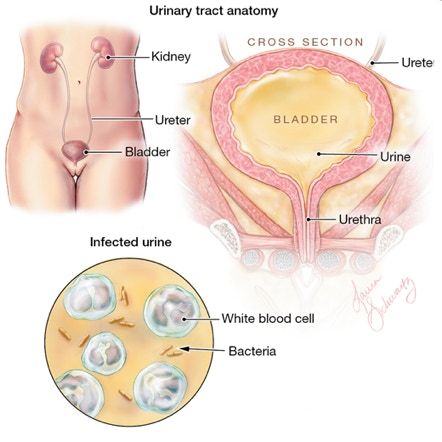

Doctors
Institutions
Conditions
Drugs
Insurances
TCM
Research
About Us
Contact Us
What are urinary tract infections (UTIs)?
Urinary tract infections are caused by bacteria along the urinary tract. The urinary tract is made up of 2 kidneys that remove liquid waste from the blood in the form of urine. Narrow tubes called ureters carry urine from the kidneys to the bladder. The urine is stored in the bladder. When the bladder is emptied, the urine travels through a tube called the urethra and passes outside the body.
Who is affected by urinary tract infections?
UTIs are uncommon in children younger than age 5, and unlikely in boys at any age, unless an obstruction is present. They are much more common in girls as a result of a shorter urinary tract. Uncircumcised males are more likely to develop UTIs than circumcised males. Children with a complete or partial blockage in the urinary tract are more likely to develop UTIs.
What causes a urinary tract infection?
Normal urine is sterile and contains fluids, salts, and waste products. It is free of bacteria, viruses, and fungi. An infection occurs when microorganisms, usually bacteria from the digestive tract, cling to the opening of the urethra, travel up into the bladder and/or kidney, and begin to multiply.
Most infections arise from Escherichia coli (E. coli) bacteria, which normally live in the colon.
What are the symptoms of a UTI?
The following are the most common symptoms of a UTI. However, each child may experience symptoms differently. Symptoms may include:
In babies:
Fever
Abdominal pain
Abdominal fullness
Foul-smelling urine
Poor growth
Weight loss or failure to gain weight
Irritability
Vomiting
Poor feeding
Diarrhea
Older children:
Urgency to urinate
Incontinence during day and/or night
Frequent urination
Painful or difficult urination
Discomfort above the pubic bone
Blood in the urine
Foul-smelling urine
Nausea and/or vomiting
Fever
Chills
Pain in the back or side below the ribs
Fatigue
Small amount of urine while voiding despite feeling of urgency
The symptoms of a UTI may look like other conditions or medical problems. Always consult your child's doctor for a diagnosis.
How are UTIs diagnosed?
Your child's health care provider may diagnose a urinary tract infection based on physical exam and a description of symptoms. Other tests may include a urinalysis (a lab test of urine for various cells and chemicals, such as red blood cells, white blood cells, infection, or excessive protein) and culture that will detect the presence of an infection.
A boy with a UTI or girls younger than age 5 or 6 may require further testing with a kidney ultrasound. This is a diagnostic imaging technique that uses high-frequency sound waves and a computer to create images of blood vessels, tissues, and organs. Ultrasounds are used to view internal organs as they function, and to assess blood flow through various vessels.
A voiding cystourethrography may also be needed in some children to evaluate the bladder and urethra and to detect reflux (in which urine backs up to the kidneys instead of flowing out through the urethra).
What is the treatment for a UTI?
Treatment may include:
Antibiotics
A heating pad or medications (to relieve pain)
Increased fluid intake (especially water)
Your child's health care provider may ask you to bring your child back into the office a few days after treatment starts to reevaluate your child.
















